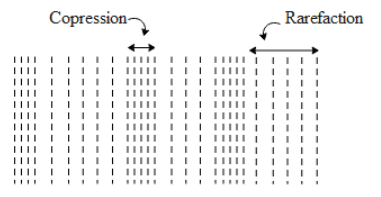
A person is listening to a tone of 500Hz sitting at a distance of 450 m sitting from the source of the sound. What is the time interval between successive compression from the source.
a) 5ms
b) 1ms
c) 2ms
d) 2s
Answer
526.5k+ views
Hint: A tone is basically a sound wave. A sound wave basically consists of a region of high pressure i.e. compression and region of low pressure i.e. rarefaction. This compression and rarefaction are periodic in nature depending on the frequency of the sound wave. Since the frequency of the wave is equal to the reciprocal of the time period we will determine the time interval between the successive compression.
Formula used:
$T=\dfrac{1}{f}$
Complete answer

Sound waves are nothing but the disturbance of the particles of the medium. A sound wave propagates a region of high pressure i.e. compression and region of low pressure I.e. rarefaction as we can see in the above diagram. These compression and rarefactions repeat themselves at regular intervals of time. The frequency of the tone heard by the man is given to be as f= 500Hz. Since the frequency of the successive compression and rarefaction of the sound wave is equal to the reciprocal of the time period, the time interval between successive compression is given by,
$\begin{align}
& T=\dfrac{1}{f} \\
& \Rightarrow T=\dfrac{1}{500} \\
& \Rightarrow T=0.002s=2\times {{10}^{-3}}s \\
& \Rightarrow T=2ms \\
\end{align}$
Hence the correct answer of the above question is option c.
Note:
The time interval of the successive compression heard by the man will be equal to the above value obtained as long as he is not moving. If the person starts moving then the frequency of the tone heard by him will be different as compared to the actual frequency of the source of the tone. The time interval of successive rarefaction heard by the man is also the same.
Formula used:
$T=\dfrac{1}{f}$
Complete answer

Sound waves are nothing but the disturbance of the particles of the medium. A sound wave propagates a region of high pressure i.e. compression and region of low pressure I.e. rarefaction as we can see in the above diagram. These compression and rarefactions repeat themselves at regular intervals of time. The frequency of the tone heard by the man is given to be as f= 500Hz. Since the frequency of the successive compression and rarefaction of the sound wave is equal to the reciprocal of the time period, the time interval between successive compression is given by,
$\begin{align}
& T=\dfrac{1}{f} \\
& \Rightarrow T=\dfrac{1}{500} \\
& \Rightarrow T=0.002s=2\times {{10}^{-3}}s \\
& \Rightarrow T=2ms \\
\end{align}$
Hence the correct answer of the above question is option c.
Note:
The time interval of the successive compression heard by the man will be equal to the above value obtained as long as he is not moving. If the person starts moving then the frequency of the tone heard by him will be different as compared to the actual frequency of the source of the tone. The time interval of successive rarefaction heard by the man is also the same.
Recently Updated Pages
NCERT Solutions For Class 4 English Marigold (Poem) - Don’t Be Afraid Of The Dark

NCERT Solutions For Class 5 English Marigold (Poem) - Class Discussion

NCERT Solutions For Class 5 English Marigold - Gullivers Travels

NCERT Solutions For Class 5 Hindi Rimjhim - Bagh Aaya Uss Raat

NCERT Solutions For Class 8 Hindi Bharat Ki Khoj - Tanaav

NCERT Solutions For Class 12 Maths - Differential Equations

Trending doubts
Which are the Top 10 Largest Countries of the World?

Differentiate between homogeneous and heterogeneous class 12 chemistry CBSE

Why is the cell called the structural and functional class 12 biology CBSE

a Tabulate the differences in the characteristics of class 12 chemistry CBSE

Who discovered the cell and how class 12 biology CBSE

Draw a labelled sketch of the human eye class 12 physics CBSE




